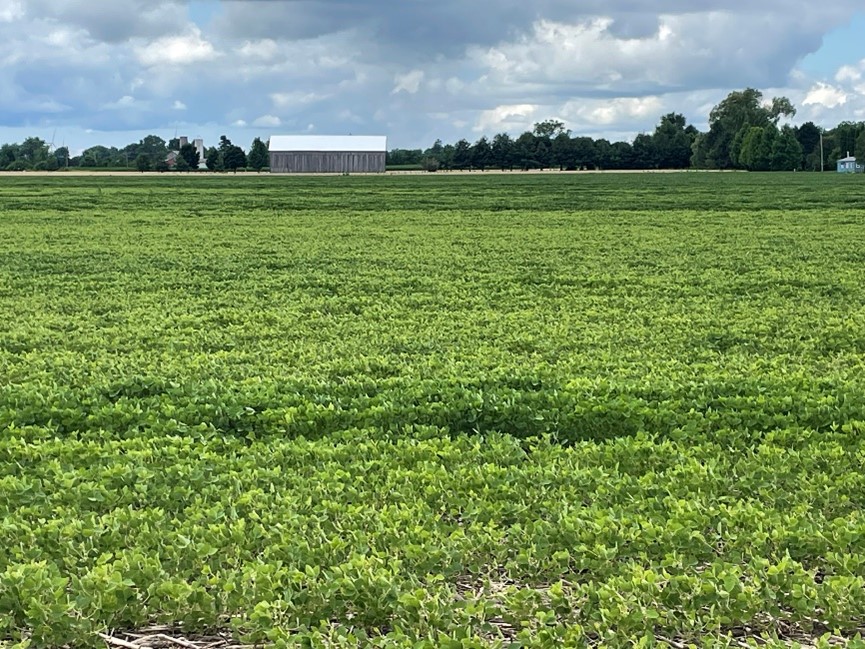Nitrogen (N) fertilizers are not usually required for soybeans as they obtain most of their nitrogen through biological N fixation and residual soil N reserves. See factsheet, Inoculation and Nodulation. Annual inoculation with the rhizobia Bradyrhizobium japonicum, ensures adequate nodulation and has provided a small yield benefit even in fields with a history of soybeans in Ontario research.
If a nodulation failure has occurred on a first-time soybean field, the application of N fertilizer is necessary to produce a high yielding crop. If nodulation did not occur by first flower apply 50 kg/ha (45 lbs/acre) to 90 kg/ha (80 lbs/ac) of actual N. Although the total uptake of the crop is higher, the plant will also use naturally available soil N reserves. Applying rates higher than 90 kg/ha (80 lbs/ac) of actual N is not economical in soybeans with a nodulation failure. Spreading urea when the foliage is dry is often the most cost-effective method. Although other sources of N are acceptable care must be taken not to burn the foliage with liquid products. The application of granular ammonium sulphate provides the additional benefit of sulfur which can be beneficial on sandy soils.
Assessing N deficiency in soybeans should not be done in haste. Under adverse growing conditions nodule formation and N fixation may be delayed but will eventually take place given more time. Occasionally, proper nodulation and N fixation can be delayed until August even in fields that have previously grown a well nodulated crop, see figure 1, Nitrogen Deficiency.

Figure 1. Nitrogen Deficiency. Yellow soybeans due to cool wet conditions in spring and early summer.
Early season dry conditions or very cool, wet weather will inhibit nodulation. Once growing conditions improve nodulation occurs. During periods of rapid growth, plants may also be N deficient for a short period of time before N fixation can catch up to demand. For this reason, a decision to apply supplemental nitrogen fertilizer to a soybean field should not be made quickly. In a field that has previously grown a well nodulated crop, the best advice is to wait as the field will recover in time. On the other hand, a first-time soybean field that has failed to properly nodulate by R2 (full bloom) will rarely do so later in the growing season and should receive an application of fertilizer N as soon as possible.
Risks of Supplemental N Application
The application of N fertilizer to soybeans has not proven to be economical in Ontario (except in fields that have suffered a nodulation failure). Excess nitrogen, especially early in the season will delay nodule formation and N fixation. If nodulation is delayed early in the season due to excess N fertilizer the plant may run out of much needed N later in the growing season when available soil N reserves run out. Up to 55 kg/ha (50 lbs/ac) of actual N can be applied pre plant to soybeans with minimal impact on nodulation. The more nitrogen fertilizer that is applied, the more nodule formation and N fixation is inhibited. Excess N also promotes vegetative growth that increases the risk of lodging and white mould.
Supplemental N fertilizer can do more harm than good. So, while a small amount of N fertilizer makes the crop look better, it usually does little to improve yields. Research has shown only a small yield gain from applying nitrogen fertilizer to a well-nodulated field. Yield gains to mid-season N fertilization have also been inconsistent. Theoretically, yield improvements are more likely if yield potential is over 80 bu/ac.
The practice of applying N fertilizer to aid corn stalk break-down has not been shown to make a measurable difference in Ontario. Occasionally, yield gains up to 5 bu/ac have been observed in fields with a high level of corn residue, but more typically gains are less than 2 bu/ac. Yield benefits are greatest in late planted fields, especially in wide rows. See Table 1, Soybean Yield Response to Nitrogen Fertilizer.
Table 1. Soybean Response to Nitrogen Fertilizer.
| Row | Treatment* | Seeding | Planting** | Yield | Yield Gain to N in Same Row Width | |
| Width | Rate | Date | bu/ac | bu/ac | ||
| 1 | 15″ | Untreated | 165 | Early May | 78.0 | |
| 2 | 30″ | Untreated | 140 | Early May | 74.3 | |
| 3 | 15″ | N | 165 | Early May | 78.4 | 0.4 |
| 4 | 30″ | N | 140 | Early May | 74.9 | 0.6 |
| 7 | 15″ | Untreated | 165 | Late May | 73.4 | |
| 8 | 30″ | Untreated | 140 | Late May | 69.1 | |
| 9 | 15″ | N | 165 | Late May | 72.8 | -0.6 |
| 10 | 30″ | N | 140 | Late May | 70.6 | 1.5 |
*N = 10 gallons/ac of 28% UAN applied on soil surface at planting streamed on the row in 2022. 87 lbs/ac of urea broadcast in 2023. Average of 6 trials. LSD = 1.4 bu/ac
**Early May = the first planting window when the soil was fit. (May 7-16) Late May = (May 30 – June 2).